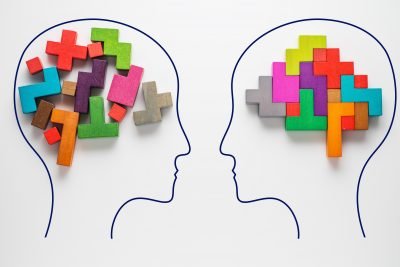Including Autism Spectrum Disorder, Learning Disabilities, and Tourette Syndrome
According to Nature:
Neurodevelopmental disorders are a group of disorders in which the development of the central nervous system is disturbed. This can include developmental brain dysfunction, which can manifest as neuropsychiatric problems or impaired motor function, learning, language or non-verbal communication.
Downloadable Resources
Adult Sibling Toolkit: A Planning Guide for Siblings of Adults with Intellectual and Developmental Disabilities
Autism Spectrum and Neurodevelopmental Disorders
Neurodevelopmental Disorders and Adaptive Functions
Autism Spectrum Disorders
According to the CDC:
Autism spectrum disorder (ASD) is a developmental disability that can cause significant social, communication and behavioral challenges. CDC is committed to continuing to provide essential data on ASD, search for factors that put children at risk for ASD and possible causes, and develop resources that help identify children with ASD as early as possible.
Downloadable Resources
A Parent’s Guide to Assessment
Alzheimer’s Disease & Down Syndrome: A Practical Guidebook for Caregivers
Autism Spectrum Disorder (Spanish Version here)
Autism, My Sibling, and Me: A Guide for Children with an Autistic Sibling
Life as an Autism Sibling: A Guide for Teens
Life Journey Through Autism: A Guide to Safety
Life Journey Through Autism: A Guide for Transition to Adulthood (Spanish Version Here)
Life Journey through Autism: Navigating the Special Education System
Next Steps: A Guide for Families New to Autism
Puberty and Children on the Autism Spectrum
Articles
Autistic Girls Going Undiagnosed Due to ‘Camouflaging’ Behaviour
Autism Spectrum Disorder: Engaging in a Social World
Depression and the Autism Spectrum
How to Prepare for a DDA Assessment
Is a Therapy Dog Right for Your Child with Autism
Websites
Autism Case Training Landing Page
Autism Focused Intervention Resources and Modules (AFIRM)
CDC: Autism Spectrum Disorder (ASD)
Northwest Autism Center
Organization for Autism Research (OAR)
Washington Autism Alliance and Advocacy (WAAA)
Washington State Resources
ALIGN: Advocates of Lopez Island Gathering for Neurodiversity
Autism Task Force of Greater Grays Harbor
Penarc – the Arc of Clallam, Jefferson, Kitsap and Mason Counties
Vietnamese Family Autism Advisory Board
Learning Disabilities
According to the Learning Disabilities Association of America:
Learning disabilities are due to genetic and/or neurobiological factors that alter brain functioning in a manner which affects one or more cognitive processes related to learning. These processing problems can interfere with learning basic skills such as reading, writing and/or math. They can also interfere with higher level skills such as organization, time planning, abstract reasoning, long or short term memory and attention. It is important to realize that learning disabilities can affect an individual’s life beyond academics and can impact relationships with family, friends and in the workplace.
Downloadable Resources
Accommodations for Students with Dyslexia
Charting the Course: Supporting the Career Development of Youth with Learning Disabilities
Dyslexia and the Brain (Spanish Version Available Here)
Dyslexia Basics (Spanish Version Available Here)
Dyslexia Testing and Evaluation
How Technology Can Help Your Child with a Learning Disability Be More Independent
IDA Dyslexia Handbook
Understanding Dysgraphia (Spanish Version Available Here)
Articles
Dyslexia Screening and Interventions: State Requirements and Resources
Dyslexia, Dysgraphia and Dyscalculia: Homeschooling The 3 D’s
My Child, the Athlete: Coaching a Child with Hidden Disabilities
What Is Dysgraphia?
Websites
International Dyslexia Association
Learning Disabilities Association of America
Tourette Syndrome
According to the Mayo Clinic:
Tourette syndrome is a disorder that involves repetitive movements or unwanted sounds (tics) that can’t be easily controlled. For instance, you might repeatedly blink your eyes, shrug your shoulders or blurt out unusual sounds or offensive words.
Tics typically show up between ages 2 and 15, with the average being around 6 years of age. Males are about three to four times more likely than females to develop Tourette syndrome.
Although there’s no cure for Tourette syndrome, treatments are available. Many people with Tourette syndrome don’t need treatment when symptoms aren’t troublesome. Tics often lessen or become controlled after the teen years.
Downloadable Resources
A Children’s Guide to Tourette Syndrome (Spanish version available here)
Bridging the Gap Between Tourette Syndrome and Public Health
CDC: Tourette Syndrome
Living with Tourette & Tic Disorders: Guide for Patients and Families (Spanish version available here)
Tics and Tourette Syndrome
Tics and Tourette Syndrome: Essential Facts for Patients
What is Tourette Syndrome?
Articles
For Author Kevin Wilson, Writing Offers A Brief Reprieve From Tourette’s
My Life With Tourette’s Syndrome
Websites
National Institute of Neurological Disorders and Stroke: Tourette Syndrome Information Page
Tourette Association of America

